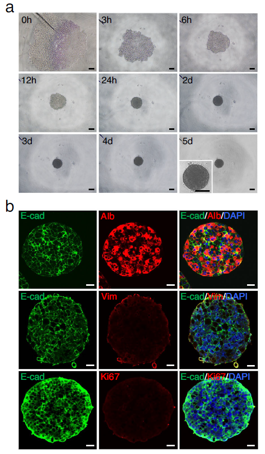- TEL:
- +81-3-5462-4831
- FAX:
- +81-3-5462-4835
※9:00-17:40 Mon.-Fri. (JST)



Shizuka Miura, Kenichi Horisawa, Tokuko Iwamori, Satoshi Tsujino, Kazuya Inoue, Satsuki Karasawa, Junpei Yamamoto,
Yasuyuki Ohkawa, Sayaka Sekiya and Atsushi Suzuki
Nat Commun 15, 3940 (2024). | https://doi.org/10.1038/s41467-024-47869-2
Copyright © Authors 2024
This article is licensed under a Creative Commons Attribution 4.0 International License (CC BY).
Hepatocytes, which constitute 80% of liver mass, rapidly lose their functional properties (e.g. metabolism, formation and secretion of bile, drug detoxification, glycogen storage, and protein synthesis) in monolayer culture due to dedifferentiation into progenitor-like cells via epithelial-mesenchymal transition. Recent studies have shown that dedifferentiation of hepatocytes is regulated by the Hippo signaling pathway, particularly through Yap activation, and is supported by factors such as Wnt signaling activation and TGF-β inhibition. This process has implications for understanding liver regeneration and therapeutic potential in liver diseases. However, the detailed cellular dynamics, mechanisms for maintaining the dedifferentiated state, and differentiation potential of dedifferentiated hepatocytes remain unclear.
|
In this study, the authors used the previously established method to isolate hepatocytes from adult mouse livers and dedifferentiate them into hepatocyte precursor cells dedifferentiated hepatocytes (dediHeps). PrimeSurface™ 96U plate was used to form dediHep aggregates to investigate its redifferentiation ability. The results demonstrate that dediHeps show a hybrid epithelial/mesenchymal phenotype, which is required for their dedifferentiation and maintenance. Importantly, dediHeps show remarkable plasticity, not only redifferentiating into mature hepatocytes but also differentiating into intestinal epithelial cells capable of forming organoids and reconstituting colonic tissues. This highlights dediHeps’ potential in regenerative medicine. |

|
Plate: PrimeSurface™ 96U plate
Cell: dedifferentiated hepatocytes (dediHeps)
Cell density: 3 x 103 cells/well
Meduim: Medium used for aggregation
Assays:
• Co-immunofluorescence staining of aggregates 5 days after initiation of 3D culture
• Gene expression between dediHep aggregates and dediHep monolayer cultures
• Transplantation of trypsinized aggregates
| Cat # | Product name | Well | Color | Bottom design | Well Vol | Package |
|---|---|---|---|---|---|---|
| MS-9096UZ | PrimeSurface™ 96U | 96 | Transparent | U bottom | 300 μL | Individual packaging 20 plates per case |
Remark